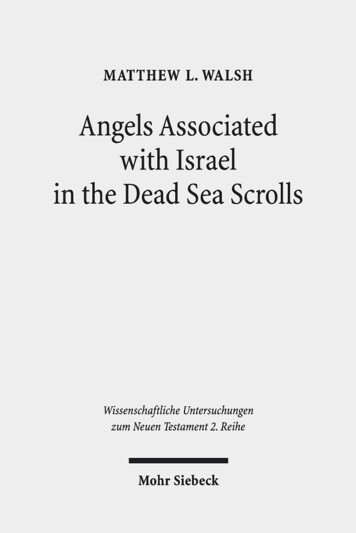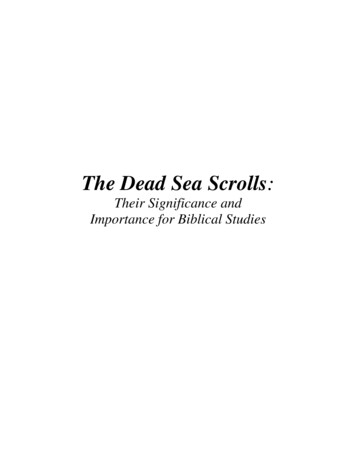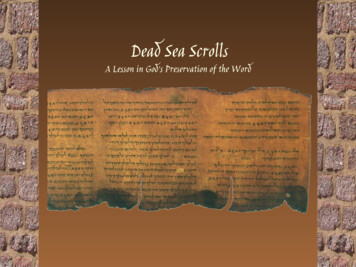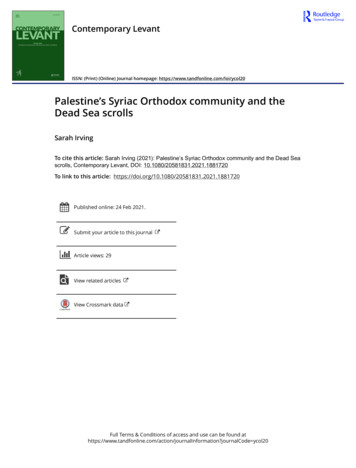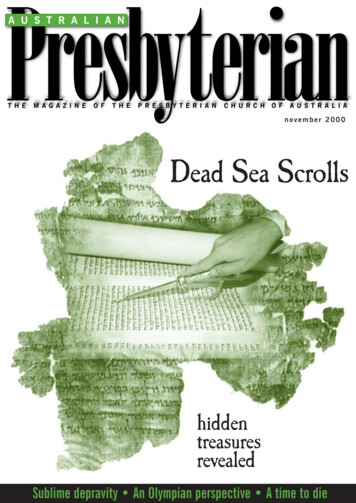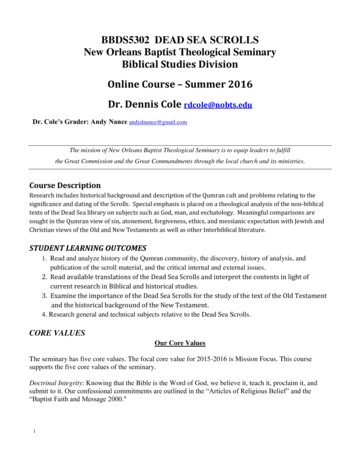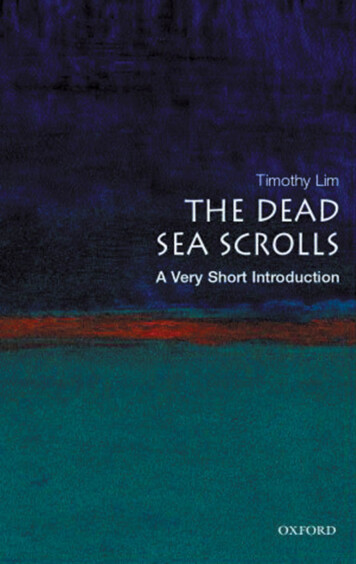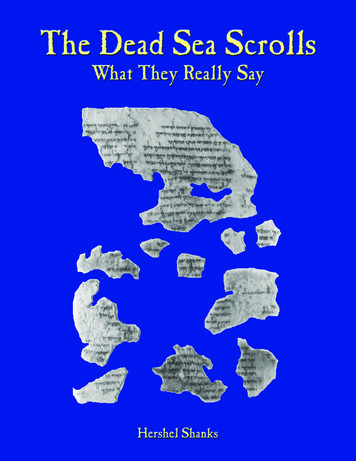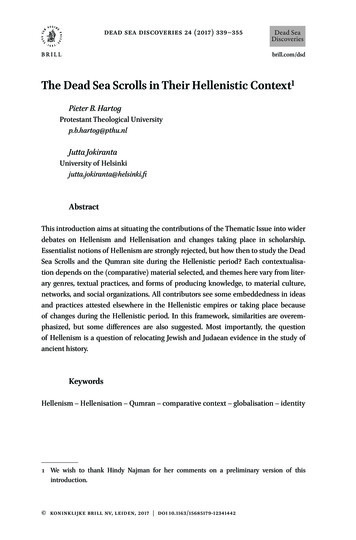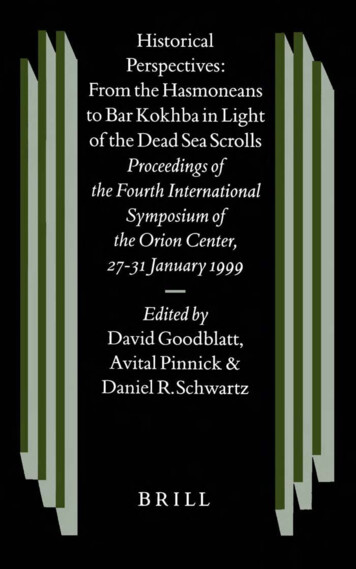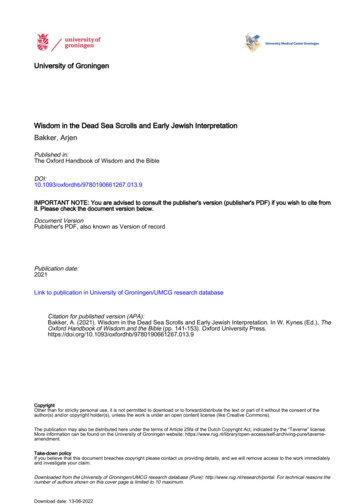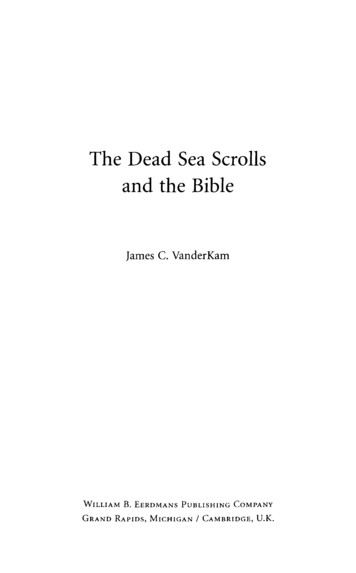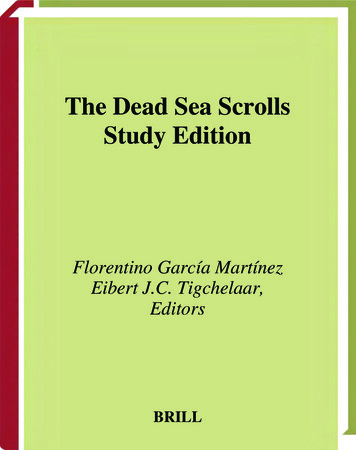
Transcription
The Dead Sea ScrollsStudy EditionFlorentino García MartínezEibert J.C. Tigchelaar,EditorsBRILL
The Dead Sea ScrollsStudy Edition
This page intentionally left blank
The Dead Sea ScrollsStudy Editionedited byFlorentino García Martínez&Eibert J.C. Tigchelaarbrillleiden new york köln1999
This book is printed on acid-free paper.Die Deutsche Bibliothek – CIP-EinheitsaufnahmeThe Dead Sea Scrolls Study Edition / ed. by Florentino GarcíaMartínez and Eibert J. C. Tigchelaar. – Leiden ; New York ; Köln :BrillLibrary of Congress Cataloging-in-Publication DataLibrary of Congress Cataloging-in-Publication Data is also available. Copyright 1997 by Koninklijke Brill nv, Leiden, The NetherlandsAll rights reserved. No part of this publication may be reproduced, translated, stored ina retrieval system, or transmitted in any form or by any means, electronic,mechanical, photocopying, recording or otherwise, without prior writtenpermission from the publisher.Authorization to photocopy items for internal or personaluse is granted by Brill provided thatthe appropriate fees are paid directly to The CopyrightClearance Center, 222 Rosewood Drive, Suite 910Danvers MA 01923, USA.Fees are subject to change.printed in the netherlands
Dedicated toAdam S. van der Woude
This page intentionally left blank
CONTENTSForeword .ixPreface to the Second Edition . xiiiAbbreviations . xvKey to Symbols. xxiiText and Translation 1Q1–11Q31 .Index of Manuscripts .Index of Titles .Index of Cave 1 Manuscripts without Serial Numbers .Index of Manuscripts not found near Qumran .vii11311132513601361
This page intentionally left blank
FOREWORDThis book is intended as a practical tool to facilitate access to the Qumran collection of Dead Sea Scrolls. As such, it is primarily intended for classroom use andfor the benefit of specialists from other disciplines (scholars working on the Hebrew Bible, the New Testament or Rabbinic literature, specialists on Semitic languages, on the History of Judaism or on the History of Religions, among others)who need a reliable compendium of all the relevant materials found in this collection. As such, it is not intended to compete with, let alone to replace, the editioprinceps of the materials published in the series Discoveries in the JudaeanDesert or outside this series, or the preliminary publications of materials whichhave not yet appeared in the DJD Series. The plates printed in the critical editions, as well as the transcriptions, translations and commentaries of the first editors are, and will always remain, the basis of all serious work on the Scrolls.Whereas the evidence of the biblical manuscripts from Qumran will be shortlyavailable in The Qumran Bible by E. Ulrich, this book offers a fresh transcriptionand an English translation of all the relevant non-biblical texts found at Qumran,arranged by serial number from Cave 1 to Cave 11. By biblical scrolls we understand here the copies of the books that subsequently emerged as the traditionalHebrew Bible, as well as the remains of tefillin and mezuzot which only containquotations of those biblical books. In several cases the distinction between biblical and non-biblical texts is not clear-cut. Thus, the so-called Reworked Pentateuch consists mainly of the biblical text of the pentateuchal books, be it sometimes in a different order, but also has some sections with material that is notincluded in the Hebrew Bible; likewise, we have included the non-biblical psalmsfrom the Psalms Scrolls 4Q88, 11Q5 and 11Q6. Not included are the scant remains of Ben Sira from Cave 2. The inclusion in the edition of these ‘additions’does not imply a judgment on their ‘biblical’ or ‘non-biblical’ character. In threecases we have included texts not found at Qumran, but related to manuscriptsfrom Qumran; this goes for the remains of the mediaeval copies of the DamascusDocument and the Aramaic Levi Document found in the Cairo Genizah, and forthe copy of the Songs of the Sabbath Sacrifice recovered at Masada.The transcriptions of the material included in this edition are fresh transcriptionsmade by the authors, though it is a very pleasant duty to recognize the debt to allprevious work by teachers and colleagues. Our transcriptions rely not only on theidentification and placement of the many tens of thousands of fragmentsachieved by the original editors of the non-biblical scrolls, who arranged the fragments for the photographs made by the Palestine Archaeological Museum in theix
foreword1950s and 1960s, and the subsequent editions of these materials by the originaleditors, but also on all the editions done by other scholars.Although we have consulted the available editions of the individual manuscripts,the responsibility for the transcriptions here presented is entirely ours. We havechecked all the proposed readings against the photographs accessible to us: thephotographs provided by the published editions, the photographs included in theBrill microfiche edition and the photographs available in the Oxford-Brill’s CDROM. In most cases one will find no or few significant differences from othertranscriptions because these readings are imposed by the univocal manuscriptevidence. In the case of ambiguous manuscript evidence, and in view of the practical purpose of this book, we have often adopted the suggestions of previouseditors, rather than presenting alternative readings for the sake of originality anddifference, even when such readings would be palaeographically or otherwisepossible. The restorations of the text offered in the transcriptions are on the wholerelatively sparse. The main exceptions are reconstructions based upon the preserved text of parallel copies of the same manuscript.A considerable part of the materials was already accessible in translation in TheDead Sea Scrolls Translated. That translation has served as the base-text of thetranslations presented in this edition, but has been thoroughly checked and corrected by the authors. Of the greatest help for this revision was the Dutch translation by A.S. van der Woude included in F. García Martínez & A.S. van der Woude,De Rollen van de Dode Zee Ingeleid en in het Nederlands vertaald (Kampen:Kok, 1994, 1995). Although we have consulted most other translations of individual manuscripts, the responsibility for the translations here presented is alsoours. The practical purpose of the book has shaped the final translation: to a largeextent literal, neutral and close to the transcribed text, even if the outcome lacksfinesse and is less fluent than some other presently available translations. On thewhole the translation aims to be a translation of the transcribed text on the facingpage. Exceptions have been made for texts like Tobit, Jubilees and 1 Enoch,where the translation fills in the lacunae on the basis of the known non-Hebrewversions for the benefit of the readers. Although we have tried to be generallyconsistent in the translation of technical terms, we have not established a chart oftranslation-equivalents to avoid imposing an uniform meaning upon texts whichmay be of different origin or of different epochs. Other differences of translation,and also, to some extent, method of transcription, may be attributed to the procedure followed by the authors: each author prepared his own lot, and revised the lotof the other author.The practical purpose of the book has also governed the selection and the presentation of the materials. We have selected the materials on the basis of their exten-x
forewordsiveness and interest, discarding most of the minute fragments which add little toour knowledge. On some occasions we have hesitantly opted for the inclusion ofvery small and insignificant fragments, only to provide some idea of the materialremains of certain compositions, and in order not to leave too many entriesempty. On the other hand, larger but, in our opinion, less interesting fragmentsfrom manuscripts have been omitted. This means that, in general, we present thelargest fragments of a manuscript, and a selection of the smaller ones. Even so,many Q numbers from the different caves are exclusively made up of unidentified or unclassified fragments, and we have not attempted to reproduce thesesnippets. In spite of this, we consider this edition relatively complete for the nonbiblical scrolls, and as such it could be useful as a companion volume with transcriptions and translations for the users of the microfiche or the CD-ROM editions of the photographs of the manuscripts.This same practical purpose has governed the presentation of the transcriptions.We have avoided all diacritical marks which indicate the degree of certainty of areading. Readings which in our view are sufficiently assured or have a high degree of probability, even if the remains are minimal, are transcribed outsidesquare brackets. When we are not reasonably assured of a reading, we have notedthe letter within square brackets, as a reconstruction, or replaced it by one or moredots. We have not reproduced the extent of lacunae; three dots within squarebrackets ([ ]) indicate any amount of missing text and three dots outside squarebrackets (] [) any amount of unreadable (either undecipherable or meaningless)letters or words. Readings corrected by a copyist are indicated within accolades.The text printed within accolades ({ }) may represent erasures, letters with cancellation dots, or text otherwise marked by the copyist as not to be read. Oneparticular type of scribal correction, the overwriting and reshaping of individualletters, has not always been presented in the transcription. The indication vacat inthe transcription, and Blank in the translation, indicate any amount of space leftblank in the manuscript, either intentionally (as indication of a new paragraph) oraccidentally. Words written above the line or in Palaeohebrew characters in themanuscript are reproduced as such in our transcription. In only a limited numberof cases we have indicated obvious mistakes in the text which have not beencorrected by the copyist. Text presented within angled brackets ( ) was writtenin the manuscripts, but should, in our opinion, be read otherwise or be deleted.Text within round brackets either presents our addition to the text, or indicates ourcorrected reading of the preceding word or words.The materials are arranged according to cave and serial number. For the materialswhich do not have a serial number (1QIsaa, 1QIsab, 1QHa, 1QM, 1QS, 1QapGen,1QpHab, and the three included non-Qumranic texts) we have adopted theprocedure of the Companion Volume to the microfiche edition, placing them inxi
forewordthe immediate vicinity of the corresponding materials which do have a serialnumber.Each entry is provided with a heading which contains a summary of essentialinformation:1 Cave number and number of the manuscript, short title (when available) andofficial or descriptive title; it should be noted that the titles of the not yet officially published manuscripts are still subject to change;2 bibliographical data of the editio princeps or of the preliminary edition;3 main PAM or SHR photographs of the manuscript;4 place where the manuscript is kept and Inventory Number of the manuscriptsin the Rockefeller Museum;5 other copies of the composition from the same cave or from other caves, whenextant;6 when appropriate, other relevant bibliographical data.In the entries corresponding to biblical manuscripts the heading is followed bythe references of the texts preserved on the individual fragments as published inthe DJD Series. For the biblical manuscripts from Cave 4 which have not yet beenpublished in the DJD Series the contents are indicated without linking them toconcrete fragments, because the precise numbering of the fragments has not yetbeen fixed. In the entries corresponding to non-biblical manuscripts, the headingsare followed by the transcription of the fragments with the translation in the facing page.Only the more relevant PAM photographs are indicated. The information onthe photographs and Museum Inventory numbers is mainly based on the datagiven in The Dead Sea Scrolls Catalogue. Documents, Photographs and MuseumInventory Numbers, Compiled by Stephen A. Reed, Revised and Edited byMarilyn J. Lundberg with the collaboration of Michael B. Phelps (SBL Resources for Biblical Study 32; Atlanta: Scholars Press, 1994). This informationhas been checked and corrected when necessary with the Companion Volume tothe Dead Sea Scrolls Microfiche Edition, Edited by Emanuel Tov with the Collaboration of Stephen Pfann, Second Revised Edition, Leiden: E.J. Brill - IDC,1995, and with the information provided in the bibliographical database of TheDead Sea Scrolls. Electronic Reference Library, Volume I, Edited by Timothy H.Lim in consultation with Philip S. Alexander, (Oxford University Press & BrillAcademic Publishers, 1997). We also wish to thank Emanuel Tov for providingus with a copy of his updated desk-copy of the inventory of photographs andmuseum inventory numbers. Only the photographs available in the microficheedition or in the CD-ROM are indicated, not other extant photographic collections of DSS materials.xii
forewordIt is a pleasant duty to acknowledge the help and to thank accordingly the manyinstitutions and individuals who have contributed to the completion of this volume. First and foremost all the original editors of the manuscripts whose namesappear at the beginning of each entry: without their pioneering work this bookwould not have been possible. It would also not have been possible without theintensive work done for almost fifty years by a large community of scholars whodedicated their efforts to increasing our understanding of these texts. Althoughwe have been forced to restrict to a minimum the bibliographical references, excluding many names and many contributions, we are deeply indebted to each andall of these scholars, and we gladly acknowledge the influence of their work onour transcriptions and translations.Hans van der Meij, Pim Rietbroek and the technical staff of Brill AcademicPublishers, have been very actively involved in all the phases of the production ofthis book; their interest and the constant care with which they have followed thewhole process have been instrumental in the completion of the book; they haveearned the thanks of the readers as well as our own.It is also a pleasure to thank the “Dirección General de Investigación yDesarrollo” of the Spanish Ministry of Education and Science, which funded thestay for a sabbatical semester in 1997 of F. García Martínez at the InstitutoUniversitario de Ciencias de las Religiones de la Universidad Complutense, andto its Director Julio Trebolle Barrera, who allowed this editor to work undisturbed on this book. Likewise, we are indebted to the “Koninklijke NederlandseAkademie van Wetenschappen” which granted E.J.C. Tigchelaar an academy fellowship for a Qumran research project.Finally, we acknowledge and thank the unfailing support of the TheologicalFaculty of the Rijksuniversiteit Groningen, our academic home base, which, withits Qumran Instituut, has established the ideal conditions for research. It is apleasure to present this book as a token of the contribution of our QumranInstituut in Groningen to the celebrations of the fiftieth anniversary of the Scrolls,and to dedicate it to A.S. van der Woude, the founder and former Director of theQumran Instituut, on the occasion of his seventieth birthday.The AuthorsGroningen, October 1997xiii
PREFACE TO THE SECOND EDITIONAs stated in the foreword to the first edition, the Dead Sea Scrolls Study Edition(DSSSE) was primarily intended for classroom use. We are therefore verypleased that the publishers have agreed to print a second, even more affordableedition. The short period which elapsed between the first publication of DSSSEand the present new edition (DSSSE2), has precluded us from thoroughly revising the work. Nevertheless, this edition contains numerous small improvementson the first edition. All typing errors, typographical inconsistencies, and accidental omissions, which we ourselves observed or which were brought to our attention, have been corrected. Occasionally we have modified the transcriptions andtranslations on the basis of our own research, or in recognition of suggestionsgraciously put forward by several colleagues all over the world. In order to facilitate the use of the book we have indicated in the running heads the numbers of thecolumns in those documents which extend over many pages. The list of abbreviations has been somewhat expanded in order to include works that are frequentlyquoted in short form in the bibliographical headings, and some of those bibliographies have been updated with references to recent publications. On the basis ofrecent authoritative publications some of the numbers of lines, fragments, or columns, have been changed, especially in 4Q255 to 4Q264, and most of the titlesgiven to the manuscripts have been brought into line with those of the latest version of the desk-copy of Emanuel Tov’s inventory. A very limited number ofchanges involves the reallocation of fragments among manuscripts or addition offragments (some changes in the listing of the 4QPsalms manuscripts; 4Q177 19has been deleted; 4Q392 and 4Q393 are now listed as one manuscript; the samegoes for 4Q509 and 4Q505; 4Q556 now includes the transcription of one fragment). Due to all these different kinds of changes some pages have been considerably modified, whereas others are still exactly the same as in the first edition.On the whole the page numbers of this second edition correspond to those of thefirst one, though occasionally the insertion or deletion of text has caused sometext to flow from one page to an other.Finally, we wish to acknowledge our debt to Martin Meijer of Bookman,Leiden, who took care of the layout of this work. Annemieke van der Kolk andBauke Koole helped us with the typing of a large part of the Hebrew text in thesevolumes. Martin Baasten, of Leiden University, called our attention to manytypo’s in the first edition. Anke Dorman, one of our students, checked all thePAM and ROC numbers by comparing them to those mentioned in other works.The AuthorsGroningen, April 1999xiv
ABBREVIATIONSBNPDAJIAAPAMROCSHRBibliothèque Nationale de ParisDepartment of Antiquities of JordanIsrael Antiquities AuthorityPalestine Archaeological MuseumRockefeller MuseumShrine of the BookThe most important editions of texts are always quoted by the short title whichprecedes the full title in the following list. Other often quoted works are generallyquoted in full, but sometimes in abbreviated form. In the case of multiple copiesof a composition, full bibliographical details are usually presented in the headings of the first manuscript, whereas abbreviated titles are given in the headingsof the other copies. Full titles of often abbreviated works are presented below.ATTM:ATTME:Book of Giants:Books of Enoch:Catalogue:Concordance:K. Beyer, Die aramäischen Texte vom Toten Meersamt den Inschriften aus Palästina, dem TestamentLevis aus der Kairoer Genisa, der Fastenrolle undden alten talmudischen Zitaten (Göttingen: Vandenhoeck & Ruprecht, 1984)K. Beyer, Die aramäischen Texte vom Toten Meer.Ergänzungsband (Göttingen: Vandenhoeck & Ruprecht, 1994)L.T. Stuckenbruck, The Book of Giants fromQumran. Texts, Translation and Commentary (TSAJ63; Tübingen: Mohr Siebeck, 1997)J.T. Milik, The Books of Enoch. Aramaic Fragmentsof Qumrân Cave 4 (Oxford: Clarendon, 1976)The Dead Sea Scrolls Catalogue. Documents, Photographs and Museum Inventory Numbers, Compiled by S.A. Reed, Revised and Edited by M.J.Lundberg, with the collaboration of M.B. Phelps(SBL Resources for Biblical Study 32; Atlanta,Georgia: Scholars Press, 1994)A Preliminary Concordance to the Hebrew and Aramaic Fragments from Qumran Cave II-X IncludingEspecially the Unpublished Material from Cave 4.Printed from a card index prepared by R.E. Brown,xv
abbreviationsCroyance des Esséniens:DJD I:DJD III:DJD IV:DJD V:DJD VI:DJD VII:DJD IX:DJD X:J.A. Fitzmyer, W.G. Oxtoby and J. Teixidor, prepared and arranged for printing by Hans-Peter Richter. Privately printed 1988É. Puech, La Croyance des Esséniens en la Vie Future: Immortalité, Résurrection, Vie éternelle?Histoire d’une Croyance dans le Judaïsme Ancien Iet II (Études Bibliques Nouvelle série 21-22; Paris:Gabalda, 1993)Qumran Cave I, by D. Barthélemy, O.P. and J.T.Milik, with contributions by R. de Vaux, O.P., G.M.Crowfooot, H.J. Plenderleith, G.L. Harding (Discoveries in the Judaean Desert I; Oxford: Clarendon,1955)Les ‘Petites Grottes’ de Qumrân. Exploration de lafalaise. Les grottes 2Q, 3Q, 5Q, 6Q, 7Q à 10Q. Lerouleau de cuivre, par M. Baillet, J.T. Milik et R. deVaux, O.P., avec une contribution de H.W. Baker(Discoveries in the Judaean Desert of Jordan III;Oxford: Clarendon, 1962)The Psalms Scroll of Qumran Cave 11 (11QPsa), byJ.A. Sanders (Discoveries in the Judaean Desert ofJordan IV; Clarendon: Oxford 1965)Qumran Cave 4. I (4Q158-4Q186), by J.M. Allegro,with the collaboration of A.A. Anderson (Discoveries in the Judaean Desert of Jordan V; Oxford:Clarendon, 1969)Qumran grotte 4. II (4Q128-4Q157), par R. de Vauxet J.T. Milik (Discoveries in the Judaean Desert VI;Oxford: Clarendon, 1977)Qumran grotte 4. III (4Q482-4Q520), par M. Baillet(Discoveries in the Judaean Desert VII; Oxford:Clarendon, 1982)Qumran Cave 4. IV: Palaeo-Hebrew and GreekManuscripts, by P.W. Skehan, E. Ulrich, J.Sanderson (Discoveries in the Judaean Desert IX;Oxford: Clarendon, 1992)Qumran Cave 4. V: Miq at maÆa e ha-Torah, by E.Qimron and J. Strugnell, in consultation with Y.Sussmann, and with contributions by Y. Sussmannand A. Yardeni (Discoveries in the Judaean DesertX; Oxford: Clarendon, 1994)xvi
abbreviationsDJD XI:DJD XII:DJD XIII:DJD XIV:DJD XV:DJD XVI:DJD XVIII:DJD XIX:DJD XX:Qumran Cave 4. VI: Poetical and Liturgical Texts.Part 1 by E. Eshel, H. Eshel, C. Newsom, B. Nitzan,E. Schuller and A. Yardeni, in consultation withJ. VanderKam and M. Brady (Discoveries in theJudaean Desert XI; Oxford: Clarendon, 1998)Qumran Cave 4. VII: Genesis to Numbers, by E.Ulrich, F.M. Cross (Discoveries in the JudaeanDesert XII; Oxford: Clarendon, 1995)Qumran Cave 4. VIII: Parabiblical Texts, Part 1,edited by H. Attridge, T. Elgvin, J. Milik, S. Olyan,J. Strugnell, E. Tov, J. VanderKam, S. White, in consultation with J. VanderKam (Discoveries in theJudaean Desert XIII; Oxford: Clarendon, 1994)Qumran Cave 4. IX: Deuteronomy, Joshua, Judges,Kings, by E. Ulrich, F.M. Cross, S. White Crawford,J.A. Duncan, P.W. Skehan, E. Tov, J. TrebolleBarrera (Discoveries in the Judaean Desert XIV;Oxford: Clarendon, 1995)Qumran Cave 4. X: The Prophets, by E. Ulrich, F.M.Cross, R.E. Fuller, J.E. Sanderson, P.W. Skehan, E.Tov, with the collaboration of C.M. Murphy, C.Niccum (Discoveries in the Judaean Desert XV; Oxford: Clarendon, 1997)Qumran Cave 4. XI: Psalms to Chronicles, by F.M.Cross, P. Flint, P. Skehan, E. Tov, J. Trebolle Barreraand E. Ulrich (Discoveries in the Judaean DesertXVI; Oxford: Clarendon, forthcoming)Qumran Cave 4. XIII: The Damascus Document(4Q266-273), by J.M. Baumgarten, on the basis oftranscriptions by J.T. Milik, with contributions by S.Pfann and A. Yardeni (Discoveries in the JudaeanDesert XVIII; Oxford: Clarendon, 1996)Qumran Cave 4. XIV: Parabiblical Texts, Part 2, edited by M. Broshi, E. Eshel, J. Fitzmyer, E. Larson,C. Newsom, L. Schiffman, M. Smith, M. Stone, J.Strugnell, and A. Yardeni, in consultation with J.VanderKam (Discoveries in the Judaean DesertXIX; Oxford: Clarendon, 1995)Qumran Cave 4. XV: Sapiential Texts, Part 1, editedby T. Elgvin, M. Kister, T. Lim, B. Nitzan, S. Pfann,E. Qimron, L.H. Schiffman, A. Steudel, in consulta-xvii
abbreviationsDJD XXII:DJD XXIII:DJD XXV:DJD XXVI:DJD XXVII:DSSHU:DSSSMM I:DSSSMM II:tion with J.A. Fitzmyer, partially based on earliertranscriptions by J.T. Milik and J. Strugnell (Discoveries in the Judaean Desert XX; Oxford: Clarendon,1997)Qumran Cave 4. XVII: Parabiblical Texts, Part 3,edited by G. Brooke, J. Collins, T. Elgvin, P. Flint, J.Greenfield, E. Larson, C. Newsom, É. Puech, L.H.Schiffman, M. Stone, and J. Trebolle Barrera, inconsultation with J. VanderKam (Discoveries in theJudaean Desert XXII; Oxford: Clarendon, 1996)Qumran Cave 11. II: 11Q2-18, 11Q20-31 by F.García Martínez, E.J.C. Tigchelaar, A.S. van derWoude, incorporating earlier editions by J.P.M. vander Ploeg, O.P., with a contribution by E. Herbert(Discoveries in the Judaean Desert XXIII; Oxford:Clarendon, 1998)Qumrân Grotte 4. XVIII: Textes hébreux (4Q5214Q528, 4Q576-4Q579) par Émile Puech (Discoveries in the Judaean Desert XXV; Oxford:Clarendon, 1998)Qumran Cave 4. XIX: 4QSerekh Ha-YaΩad and TwoRelated Texts, by P.S. Alexander and G. Vermes(Discoveries in the Judaean Desert XXVI; Oxford:Clarendon, 1998)Aramaic, Hebrew and Greek Documentary Textsfrom NaΩal ºever and Other Sites. With an Appendix Containing Alleged Qumran Texts (The SeiyâlCollection II), by H.M. Cotton and A. Yardeni (Discoveries in the Judaean Desert XXVII; Oxford:Clarendon, 1997)E.L Sukenik, ( אוצר המגילות הגנוזות Jerusalem: MosadBialik/The Hebrew University, 1954) The DeadSea Scrolls of the Hebrew University (Jerusalem:Magnes Press/The Hebrew University, 1955)The Dead Sea Scrolls of St. Mark’s Monastery. Volume I: The Isaiah Manuscript and the HabakkukCommentary, edited by M. Burrows with the assistance of J.C. Trever and W.H. Brownlee (New Haven: The American Schools of Oriental Research,1950)The Dead Sea Scrolls of St. Mark’s Monastery. Volume II. Fascicle 2: Plates and Transcription of thexviii
abbreviationsManual of Discipline, edited by M. Burrows withthe assistance of J.C. Trever and W.H. Brownlee(New Haven: The American Schools of Oriental Research, 1951)DSSU:R. Eisenman, M. Wise, The Dead Sea Scrolls Uncovered (Shaftesbury, 1992)Écrits préesséniens:J.T. Milik, ‘Écrits préesséniens de Qumrân:d’Hénoch à Amram’, in M. Delcor (ed.), Qumrân:Sa piété, sa théologie et son milieu (BETL 46; ParisGembloux: Duculot, 1978) 91-106Legal Texts:M. Bernstein et al. (eds.), Legal Texts and Legal Issues. Proceedings of the Second Meeting of the International Organization for Qumran Studies Cambridge 1995. Published in Honour of Joseph M.Baumgarten (STDJ 23; Leiden: Brill, 1997)MPAT:J.A. Fitzmyer, D.J. Harrington, A Manual of Palestinian Aramaic Texts (Biblica et Orientalia 34;Rome: Biblical Institute Press, 1978)Madrid Qumran Congress: J. Trebolle Barrera, L. Vegas Montaner (eds.), TheMadrid Qumran Congress on the Dead Sea Scrolls18-21 March 1991 (STDJ 11; Leiden: E.J. Brill,1993)Microfiche:The Dead Sea Scrolls on Microfiche. A Comprehensive Facsimile Edition of the Texts from the JudeanDesert, edited by E. Tov with the collaboration ofS.J. Pfann (Leiden: E.J. Brill – IDC, 1993)Midrasch:A. Steudel, Der Midrasch zur Eschatologie aus derQumrangemeinde (4QMidrEschata,b). MaterielleRekonstruktion, Textbestand, Gattung und traditionsgeschichtliche Einordnung des durch 4Q174(‘Florilegium’) und 4Q177 (‘Catena A’) repräsentierten Werkes aus den Qumranfunden (STDJ 13;Leiden: E.J. Brill, 1994)‘Milkî- edeq’:J.T. Milik, ‘Milkî- edeq et Milkî-re·a‘ dans lesanciens écrits juifs et chrétiens’, JJS 23 (1972) 95144Minor Prophets:R.E. Fuller, The Minor Prophets Manuscripts fromQumrân, Cave 4 (Diss. Harvard 1988)‘Notes’:J. Strugnell, ‘Notes en marge du volume V des “Discoveries in the Judaean Desert of Jordan”’, RevQ 7/26 (1970) 163-276, pls. I-VIxix
Notre Dame Symposium:E. Ulrich, J. VanderKam (eds.), The Community ofthe Renewed Covenant. The Notre Dame Symposium on the Dead Sea Scrolls (Notre Dame, 1994)Pesharim:M.P. Horgan, Pesharim: Qumran Interpretations ofBiblical Books (CBQMS 8; Washington, D.C.:Catholic Biblical Association, 1979)Pomegranates:D. Wright et al. (eds.), Pomegranates and GoldenBells: Studies in Biblical, Jewish, and Near EasternRitual, Law, and Literature in Honor of JacobMilgrom (Winona Lake, Ind.: Eisenbrauns, 1995)Provo Conference:D.W. Parry, E. Ulrich (eds.), The Provo International Conference on the Dead Sea Scrolls: Technological Innovations, New Texts, and ReformulatedIssues (STDJ 30; Leiden; Boston; Köln: Brill, 1999)PTSDSSP 1:The Dead Sea Scrolls. Hebrew, Aramaic, and GreekTexts with English Translations. Volume 1: Rule ofthe Community and Related Documents, edited byJ.H. Charlesworth with F.M. Cross, J. Milgrom, E.Qimron, L.H. Schiffman, L.T. Stuckenbruck andR.E. Whitaker (Tübingen – Louisville: J.C.B. Mohr- Westminster John Knox Press, 1994)PTSDSSP 2:The Dead Sea Scrolls. Hebrew, Aramaic, and GreekTexts with English Translations. Volume 2: Damascus Document, War Scroll and Related Documents,edited by J.H. Charlesworth, with J.M. Baumgarten,M.T. Davis, J. Duhaime, Y. Ofer, H.W.L. Rietz,J.J.M. Roberts, D. Schwartz, B.A. Strawn, and R.E.Whitaker (Tübingen - Louisville: J.C.B. Mohr –Westminster John Knox Press, 1995)PTSDSSP 4A:The Dead Sea Scrolls. Hebrew, Aramaic, and GreekTexts with English Translations. Volume 4A: Pseudepigraphic and Non-Masoretic Psalms and Prayers,edited by J.H. Charlesworth and H.W.L. Rietz withP.W. Flint, D.T. Olson, J.A. Sanders, E.M. Schuller,and R.E. Whitaker (Tübingen – Louisville: J.C.B.Mohr - Westminster John Knox Press, 1997)Qumran and Apocalyptic: F. García Martínez, Qumran and Apocalyp
This book is intended as a practical tool to facilitate access to the Qumran collec-tion of Dead Sea Scrolls. As such, it is primarily intended for classroom use and for the benefit of specialists from other disciplines (scholars working on the He-brew Bible, the New Test
